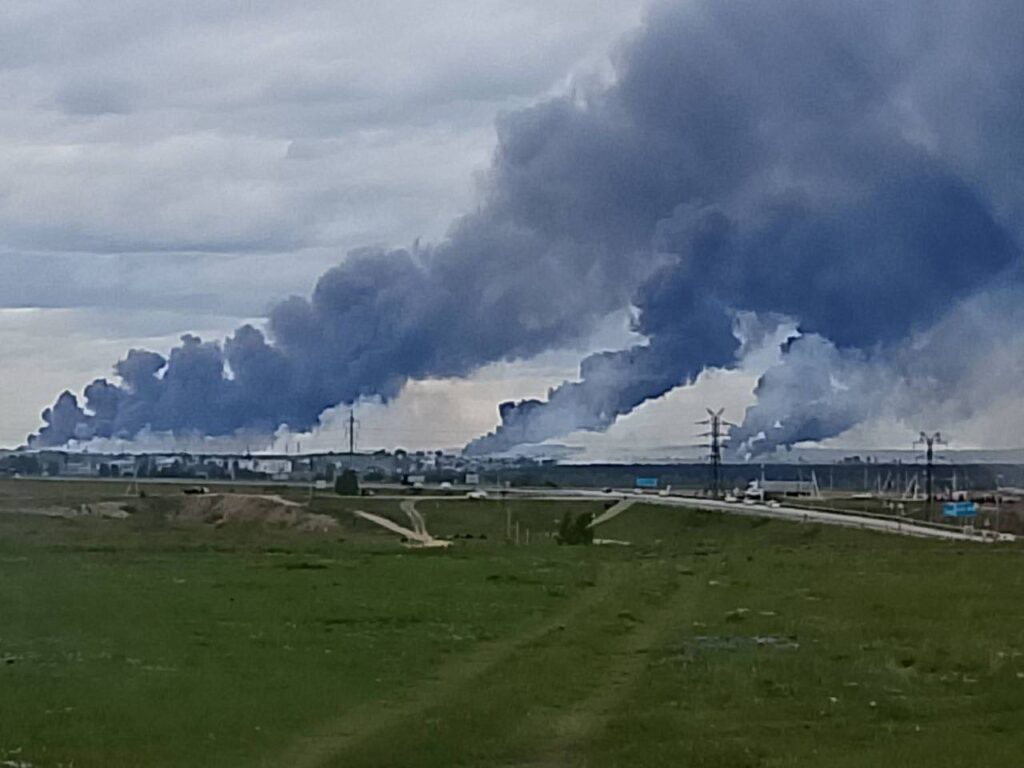Ukrainian Drones Launch Daring Strike on Russian Airbases: Over 40 Aircraft Damaged

In a bold and unprecedented operation, Ukrainian forces executed a large-scale drone attack on multiple Russian military airbases on Sunday, June 1, 2025, striking over 40 aircraft, including strategic bombers critical to Russia’s war efforts. The operation, dubbed “Spiderweb” or “Pavutyna,” targeted key airfields deep within Russian territory, marking one of the most significant Ukrainian strikes since the conflict began in February 2022.
Details of the Attack
According to Ukrainian security officials, the operation was meticulously planned over 18 months under the direct supervision of President Volodymyr Zelenskyy and Vasyl Maliuk, head of the Security Service of Ukraine (SBU). The SBU deployed 117 first-person-view (FPV) drones, smuggled into Russia and hidden inside mobile wooden cabins with retractable roofs mounted on trucks. At the precise moment, these roofs were remotely opened, allowing the drones to launch and strike their targets.
The targeted airbases included:
- Belaya airbase in Irkutsk, over 4,000 km from Ukraine, hosting Tupolev Tu-22M supersonic bombers.
- Olenya airbase in Murmansk, approximately 1,800 km from Ukraine.
- Dyagilevo in Ryazan and Ivanovo airbases, which house strategic bombers and military transport aircraft.
- A fifth base in the Amur region was also reportedly hit.
Ukrainian sources claim the strikes hit 41 aircraft, including Tu-95 and Tu-22M strategic bombers used for long-range missile attacks on Ukraine, and A-50 airborne early warning and control planes critical for coordinating Russian air operations. The SBU estimated the financial damage to Russia at $7 billion, with potential for more losses as assessments continue.
Unverified videos circulating on social media show aircraft, including Tu-95 bombers, engulfed in flames at the Belaya airbase, with some planes shielded only by tires—an apparent Russian tactic to confuse Ukrainian targeting systems.
Russian Response and Context
Russia’s Defense Ministry confirmed the attacks, labeling them “terrorist” strikes, and reported that several aircraft caught fire but were extinguished, with no casualties. The ministry also noted drone activity in the Murmansk, Irkutsk, Ivanovo, Ryazan, and Amur regions. Local governors, including Irkutsk’s Igor Kobzev, acknowledged the strikes, marking the first reported Ukrainian drone attack in Siberia.
The Ukrainian operation followed Russia’s largest drone assault on Ukraine to date, with 472 drones and seven missiles launched overnight Saturday, killing at least 12 Ukrainian service members and injuring over 60 at a training site. Ukrainian Air Force spokesperson Yuriy Ignat called it the biggest single-night drone attack since the war began.
Strategic Implications
President Zelenskyy hailed the operation as “absolutely brilliant,” predicting it would be remembered in history books. The strikes, executed on the eve of peace talks in Istanbul, demonstrate Ukraine’s ability to project power deep into Russian territory, potentially weakening Russia’s air capabilities. Ukrainian military blogger Oleksandr Kovalenko noted that hitting 40 of Russia’s estimated 120 strategic bombers represents a significant blow, even if some aircraft were only damaged.
The operation underscores Ukraine’s growing reliance on domestically produced drones to counter Russia’s superior missile arsenal. Companies like TAF Drones and groups like Wild Hornets, with their “Queen Hornet” model, are scaling up production to support such long-range missions.
Diplomatic Context
The strikes come just before a second round of ceasefire talks in Istanbul, with Ukraine’s delegation led by Defense Minister Rustem Umerov. Zelenskyy emphasized an unconditional ceasefire, prisoner releases, and the return of deported Ukrainian children as priorities. Ukrainian officials had requested a Russian memorandum outlining Moscow’s ceasefire position, which Russia promised to deliver during the talks. Notably, Ukraine did not notify the Trump administration of the operation in advance, according to some sources, though others contradict this claim.
Global Reaction
The audacious attack has drawn international attention, with analysts noting its psychological and strategic impact on both Russia and Ukraine’s Western allies. Ukrainian journalist Illia Ponomarenko, posting on X, framed the strikes as a defiant response to narratives urging Ukraine to surrender, referencing Zelenskyy’s tense encounters with U.S. leadership. The operation has sparked discussions on X, with users reporting Russia’s emergency security council meeting and widespread shock at the breach of Russian defenses.
What’s Next?
As both sides prepare for talks, the strikes signal Ukraine’s resolve to maintain military pressure while negotiating. The SBU vowed to continue targeting Russian assets “at sea, in the air, and on the ground,” suggesting more operations may follow. Meanwhile, Russia’s advances in Ukraine’s Sumy region and ongoing drone and missile strikes indicate the conflict remains intense.
This historic operation not only showcases Ukraine’s innovative tactics but also raises the stakes for upcoming diplomatic efforts, with the world watching closely.





